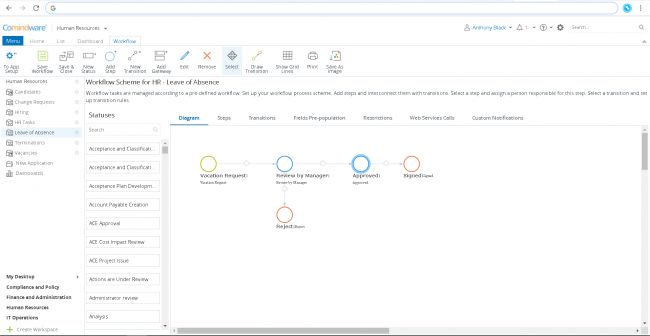One key part of employee dissatisfaction is using old techniques that waste time and money, leaving more work for employees than is necessary to deal with a given process. This is still often especially true when it comes to leave management.
Leave management simply refers to the management of employee leave, whether it is sick leave, vacation time, or some other form of leave. Outmoded tools mean this process takes way more time and effort than is necessary, especially when there are so many great automation tools that take all the frustration and guesswork out of the process.
Paper trails, bad data, and the like make this process way more frustrating than it needs to be. Timesheets, emails, phone calls, it can get out of hand pretty quickly. Managing employees’ time off doesn’t need to be this frustrating and complicated endeavor and with workflow management software by Comindware leave management has never been easier or less frustrating.
Five Common Problems and How Automation Can Improve the Process
Human resources departments are tasked with managing a lot of different activities and functions, so software that can make their job easier not only helps to improve employee satisfaction, it increases efficiency and reduces lag time and errors.
1) Who is off and when?
Especially when it comes to team projects, there being darkness surrounding when and how long an employee may be off work for vacation, sick leave, or otherwise can put a damper and halt on a project in progress. Finding out that people on your team will be gone for “x” amount of time, smack dab in the middle of an important project is incredibly irritating.
With leave management software, this information will be easily accessible for all employees and the software helps take into account important or timely tasks that may coincide with the time an employee wanted off.
2) How long do I have to wait to get approval?
HR staff is notoriously overworked and everyone has different ways of email inbox management. There isn’t much more irritating to employees than sending out a request for time off and then waiting, and waiting, and waiting, for the HR person in charge to get around to responding to an email or phone call
With leave management software, this process is automated. There is no middle man. Multiple people requesting the same day off will be readily apparent and scheduling gaps and issues are less likely to occur. So not only do employees not have to wait forever, but there are fewer issues of too many people being off at the same time.
3) How much time do I have off?
HR professionals answer this question far more often than they would like to. It is redundant and repetitive and takes time out of their day to provide this basic information. Leave management software makes all that information easily accessible to the necessary parties.
4) What happened to all my leave?
One issue that employees often face is not knowing that they are requesting more leave than they have available to them which can cause them to go without pay or be denied for time off because they simply don’t have enough for their vocation/sick leave request. With leave automation software, this information is easily accessible and allows the employee to manage their own time off.
5) Why does it say I took a day off when I didn’t?
Sometimes the unexpected happens and people have to take a day off without planning to do so. This can lead to confusion as to the number of days off an employee still has. Further, issues can come up with an employee who may dispute that they took a given day off. This can all be easily dealt with leave management software where everything will automatically be documented and available for the respective parties to see and use.
Human resource professionals have to wear so many different proverbial hats that it is easy to see why it is such an overwhelming job that many can get burnt out on. With automation software like leave management software, some of these processes can be made much easier. For example, Comindware Tracker allows for automatic requests and approval for time off. It makes it easy for both human resources and employees to check their time balances and what has been taken already. This reduces confusion, streamlines the process of requesting and getting time off, and more.

